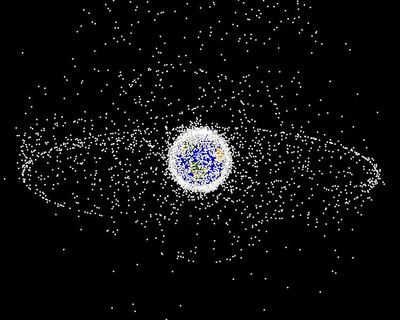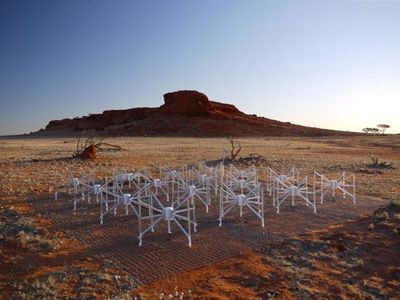Radio reflections to keep satellites safe
Western Australia’s super-sensitive Murchison Widefield Array radio telescope has been used to detect space junk, just by listening to the reflections of broadcast radio signals.
A combination of pop songs, talkback radio and cutting-edge science has enabled Australian astronomers to identify a way to prevent catastrophic, multibillion-dollar space junk collisions, a new study has revealed.
The inaugural research project spearheaded by Curtin University in Western Australia will use the newly operational Murchison Widefield Array (MWA), one of three precursor telescopes for the $2 billion Square Kilometre Array (SKA) project, to detect radio waves reflecting off thousands of objects orbiting the earth.
The study has already tracked radio waves from FM transmitters located near Perth and Geraldton bouncing off the International Space Station as it passed over WA, approximately 500 kilometres above the Earth’s surface.
Team leader Professor Steven Tingay, director of the MWA at Curtin University and chief investigator in the Australian Research Council Centre for All-sky Astrophysics (CAASTRO), said the MWA will be able to detect the space junk by listening in to the radio signals generated by stations including popular youth network Triple J.
“We have shown that we are able to detect approximately 10 pieces of space junk simultaneously. Over time this means we are in a position to monitor a significant fraction of the space junk that is in Earth orbits,” Professor Tingay explained.

The importance of this is that space debris is unpredictable and poses a significant collision risk to expensive space infrastructure, such as communication satellites, according to Professor Tingay.
“An early warning system has the potential to protect the billions of dollars’ worth of vital infrastructure orbiting the earth but also prevent collisions that will result in even more space debris being generated, such as what happened in the case of the Iridium 33 satellite in 2009,” he said.
Low cost, high return
MWA is the first of three technology and science SKA precursor telescopes to become operational. It was officially launched on 9 July 2013.
The $2 billion SKA is a global mega-science project to develop the world’s largest and most sensitive radio telescope. MWA is the only low-frequency SKA precursor and its success is a significant factor in Australia being named as the host site for SKA-low.
The MWA is a low-frequency interferometric telescope, consisting of 128 aperture array ‘tiles’, made up of 2048 fixed dual-polarisation dipole antennas. These have been placed in a core region 1.5 kilometres across, with the remainder placed more widely, giving a maximum baseline of three kilometres. The array is entirely static.

Data processing and storage is undertaken at the Pawsey High Performance Computing Centre for SKA Science. The 128 tiles transmit the individual antenna signals to 16 receiver packages for initial processing in the field, after which the data is correlated on-site and transmitted on a dedicated optical fibre data link to Perth to be archived and further processed for science.
The total cost of the MWA is $51 million. Each antenna costs approximately $3000 (significantly less than a high-frequency dish telescope which costs in the region of $500,000). The main investment relates to the data processing and storage components.
Benefiting people in everyday life
Being one of the first completed studies undertaken using the $51 million MWA, the results are important as they confirm the revolutionary astronomy tool is functioning in line with expectations.
“The MWA was designed to be the most powerful low-frequency radio telescope in the Southern Hemisphere and this was our chance to test its capabilities,” Professor Tingay said.
“Prior to undertaking the study we had calculated how strong we expected the signals to be using simulations and theory.
“The measurements we took as part of the study were spot on in agreement with our calculations.”
The idea to use the MWA for tracking space debris came from an earlier study by Ben McKinley, a CAASTRO PhD student at The Australian National University, who was able to image the Moon using reflected FM signals and calculate the likelihood that alien civilisations were listening in on us.
“CAASTRO’s emphasis on all-sky astronomy naturally leads to this new capability with the MWA, showing that astrophysics research can cross over into having significant benefits for people in everyday life,” Professor Tingay concluded.
2024–25 Thought Leaders: Tim Karamitos
Tim Karamitos from Ericsson discusses the growth of private 5G networks, the importance of...
ARCIA update: that's a wrap for 2024
That's it, 2024 is a wrap as far as ARCIA is concerned — and what a year 2024 has been...
RFUANZ report: a call to action on training
RFUANZ has been supporting industry training provider E-tec in the development of a Level 4 NZQA...





